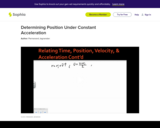
This lesson [2:00] will define the phrase corresponding parts (e.g. angles, sides, etc.). It is 1 of 5 in the series titled "Corresponding Parts."
- Subject:
- Mathematics
- Material Type:
- Audio/Video
- Provider:
- Sophia Learning
- Date Added:
- 12/01/2023

This lesson [2:00] will define the phrase corresponding parts (e.g. angles, sides, etc.). It is 1 of 5 in the series titled "Corresponding Parts."

This lesson [4:27] will define the phrase corresponding parts (e.g. angles, sides, etc.). It is 2 of 5 in the series titled "Corresponding Parts."

This lesson introduces the concept of the cotangent of an angle. It is 4 of 5 in the series titled "Cotangent." [2:21]

This lesson [2:18] shows how to calculate the desired outcomes in a probability experiment or problem.

This lesson [3:31] shows how to calculate the desired outcomes in a probability experiment or problem. It is 2 of 8 in the series titled "Counting Desired Outcomes."

This video tutorial investigates cross sections of geometric solids and provides examples of the drawings. Students can check their understanding with an assessment. [4:21]

A list of terms and examples followed by three videos on how modifiers function within a sentence [2:53], how to identify and correct dangling modifiers [10:15], and how to identify and correct misplaced modifiers. [7:28]

A screencast lesson introducing the usage of dashes and hyphens and explaining how to create both punctuation marks in a Word document. [5:07]

A video module showing that to determine a decrease in momentum you should look at impulse. Videos explores the equation for impulse and its application. Also given in lesson is an example of how to decrease momentum. [4:59]

A narrated video tutorial defines two types of heat exchanges: heat of fusion and heat of vaporization. The content focuses on the relationship between heat energy either absorbed or released, and arrangement of particles. [3:42]

Find out how ionic compounds dissociate into positive and negative ions in an aqueous solution. [1:59]

This video lesson introduces denotation and provides examples. It is 1 of 3 in the series titled "Denotation." [2:54] L.9-10.5b nuances, L.11-12.5b Nuance

This tutorial focuses on describing an author's style. It explains the five main elements constituting style: syntax, diction, punctuation, sensory details, and literary/rhetorical devices. It lists nine common writing styles and gives an example from literature showing how to determine an author's style. [5:12]

Use this lesson to help understand how to calculate the difference in electronegativity to determine whether a bond is ionic, polar covalent, or nonpolar covalent. [6:55]

Brief video presentation shows how to use a globe to determine direction. [2:19]

A narrated tutorial which shows how to find the position of an object undergoing constant acceleration. [8:48]

Congruent triangles are investigated in this video lesson. The tutorial demonstrates how to use four tricks to determine if triangles are congruent. Students can check their understanding with an assessment. [5:27]

This video tutorial describes four ways to determine if two triangles are congruent. Students can check their understanding with an assessment. [5:40]

Learn how to find the conjugate of a complex number. [4:38]

Learn how to find the conjugate of a complex number. [3:31]